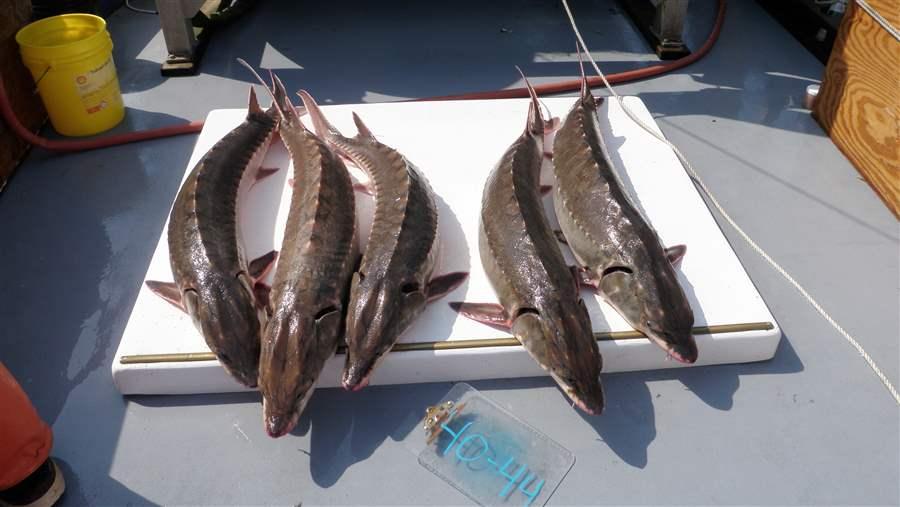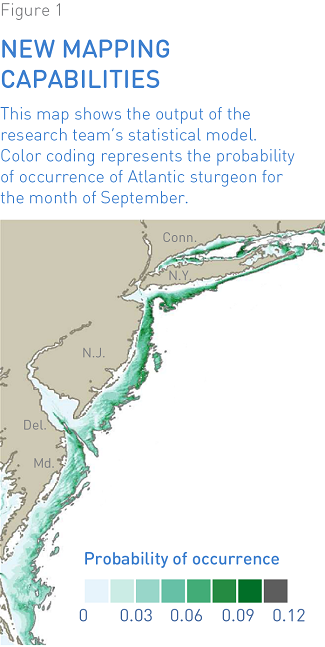New Study to Help Fishermen Avoid Endangered Sturgeon

Atlantic sturgeon sampling off the coast of Delaware in the Atlantic Ocean. Activities authorized under NMFS Permit No. 16507-01.
© Courtesy of Delaware State UniversityScientists can now predict the presence of Atlantic sturgeon with 88 percent accuracy based on environmental conditions and a new statistical model. This advance holds the potential to help fishermen continue to fish while avoiding an endangered species.
The challenge: Avoiding bycatch of endangered Atlantic sturgeon
The United States banned commercial fishing for Atlantic sturgeon in 1998, and in 2012 it declared five populations endangered or threatened. Threats include dredging, ship strikes, and power plant intakes, as well as catch by fishing vessels targeting other species, also known as incidental catch or bycatch.
Federal limits are expected soon on bycatch. If these limits are exceeded, it could trigger a suspension of fishing in a specific area, or of fishing with a certain gear type. One of the groups most likely to be affected by federal limits would be Mid-Atlantic gillnet fishermen, who target a range of species, including croaker, skates, and monkfish. Fishermen would like to avoid a suspension, along with the work involved in hauling aboard and releasing an Atlantic sturgeon, which can weigh up to 800 pounds.
A new solution: Predicting sturgeon location with environmental data
To help fishermen avoid sturgeon and keep fishing, scientists at the University of Delaware built a statistical model to predict the presence or absence of sturgeon based on environmental conditions. Their study (Breece et al. 2017) was recently published in the ICES Journal of Marine Science, with support from the Lenfest Ocean Program and in collaboration with Delaware State University.
The first step in this research was to gather data to identify conditions favorable to Atlantic sturgeon. The researchers used data from approximately 300 fish fitted with acoustic tags, which emit a unique sound. These sounds can be picked up by a set of 88 underwater microphones moored in the coastal waters of Maryland, Delaware, and New Jersey. Between 2009 and 2013, the microphones detected 210 individual sturgeon a total of 1,900 times.
Based on these data, the researchers built a statistical model to forecast sturgeon presence or absence. They compared the ocean conditions at the time of the 1,900 detections—or “presences”—with conditions during about 140,000 confirmed “absences”— days when an individual microphone was operating but did not detect any sturgeon.
This comparison revealed four important factors: sea surface temperature, water depth, time of year, and ocean color (measured using satellite imagery). Sturgeon appear to favor surface temperatures around 18 degrees Celsius (64.4 Fahrenheit), and to prefer shallow water in spring and deep water in fall. They also seem to prefer a specific ocean color, likely because color indicates habitat features such as turbidity, salinity, and the presence of nutrients.
Results: Accurate predictions, confirmed with bycatch data
Using these four factors, the model was able to correctly identify 88 percent of the presences and 71 percent of the absences in the data. The 29-percent error rate for absences may have occurred because, in a large number of cases, conditions were conducive to sturgeon, but none was detected. This is to be expected for such a rare species. The error rate could also stem from other sources, such as environmental factors not included in the model.
One final step was to test whether the model was applicable beyond the initial dataset. For this test, the researchers used 661 historic records of sturgeon caught as bycatch by fishermen between Cape Cod and the Chesapeake Bay. Each of these is by definition a “presence.” Using the same four environmental factors, the model correctly predicted presence for 66 percent of all the catches, and for 91 percent of those from April through October, which is when most sturgeon bycatch occurs.
Available online now: Daily sturgeon predictions
The model’s daily predictions are now available at http://www.ceoe.udel.edu/our-people/profiles/moliver/orb-lab/real-time-satellite-data/real-time-sturgeon-predictions.
The website currently shows areas of high, medium, and low risk of sturgeon bycatch in the Mid-Atlantic. The researchers plan to make improvements by the end of 2017 that will enable fishermen to better use the site to guide decisions about where to fish. They are also working with NASA to expand their mapping capabilities. And in 2018, they plan to launch a text messaging system to alert fishermen to areas where Atlantic sturgeon bycatch is likely, in partnership with the Delaware Department of Natural Resources and Environmental Control.
This approach is potentially applicable to any species or region where similar data are available. The University of Delaware researchers plan to apply it next to several imperiled Mid-Atlantic species.
Citation
Breece, M. W., Fox, D. A., Haulsee, D., Wirgin, I., and Oliver, M. J. (2017), Satellite Driven Distribution Models of Endangered Atlantic Sturgeon Occurrence in the Mid-Atlantic Bight. ICES Journal of Marine Science, doi:10.1093/icesjms/fsx187.


